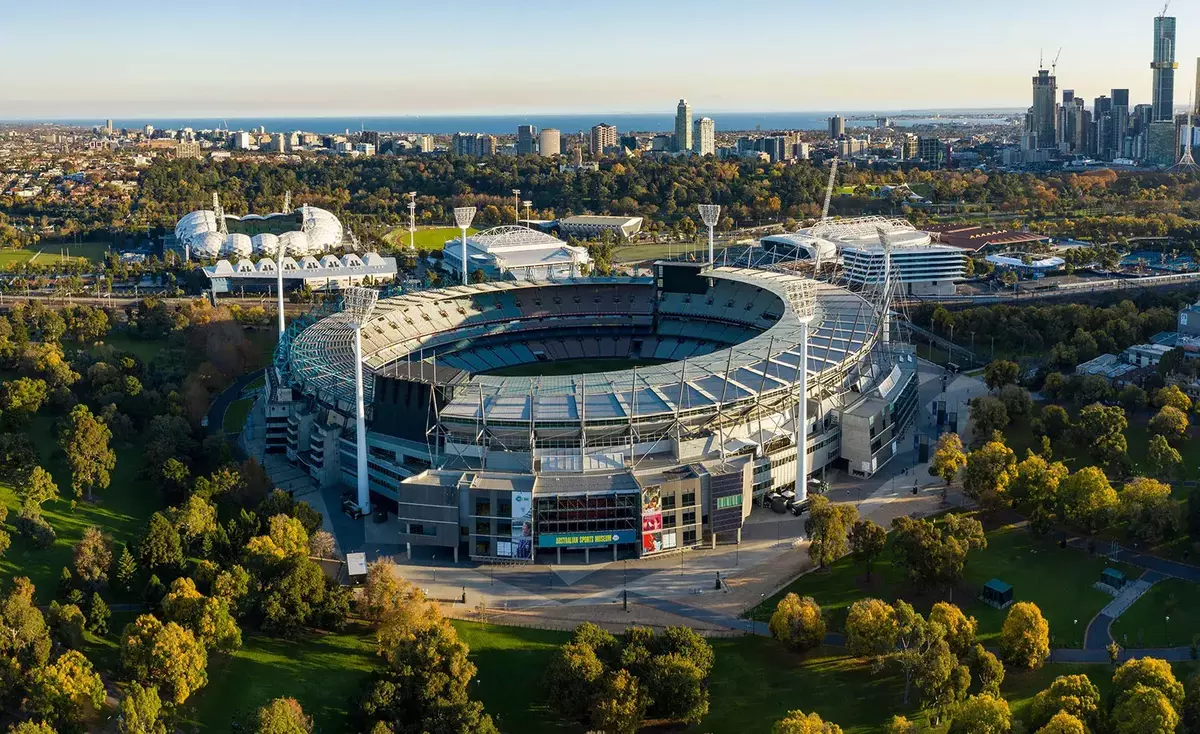
The Melbourne Cricket Ground (MCG), known locally as “The ‘G“, is an iconic Australian sports stadium situated in Yarra Park, Melbourne, Victoria.
Founded in 1853, mark itself as one of the oldest ground and stands as the largest stadium in the Southern Hemisphere and the second-largest cricket ground by capacity globally.
The MCG has a storied history in international cricket, hosting the first Test match and One Day International between Australia and England in 1877 and 1971, respectively.
It has undergone several renovations, including major redevelopments in 1992 and 2003-2005, which have shaped its current state. Let’s explore each MCG’s history.
Summary & Key Takeaways
ShowMelbourne Cricket Ground Overview
-
Location: Yarra Park, Melbourne, Victoria, Australia.
-
Establishment: Founded in 1853.
-
Management: Managed by the Melbourne Cricket Club.
-
Capacity: Seating capacity of approximately 95,000 with an additional 5,000 standing room (Total capacity: 100,024).
-
Significance: Largest stadium in the Southern Hemisphere and second-largest cricket ground globally by capacity.
Historical Significance
-
First Matches: Hosted the first Test match and One Day International in 1877 and 1971, respectively.
-
Renovations: Major redevelopments in 1992 and 2003-2005.
-
Events: Hosted the 1956 Olympic Games, Cricket World Cup finals in 1992, and numerous other significant sports events.
Stadium Features
-
Lighting and Screens: Six massive light towers and two large LED high-definition video screens.
-
Pitch: Drop-in pitches cultivated from Merri Creek black soil.
-
Facilities: National Sports Museum, various stands, and accessibility options for public transport and parking.
Memorable Matches and Moments
-
Iconic Matches: Inaugural Test and One Day International matches, 1992 Cricket World Cup final, Boxing Day Test matches.
-
Record Performances: Notable cricketing feats like Donald Bradman's and Matthew Hayden's innings.
-
Historical Events: Hosting the 1956 Olympics, memorable AFL Grand Finals.
Pitch and Conditions
-
Characteristics: Known as a pacer's paradise with a consistent and true bounce.
-
Evolution: Transition from natural grass to drop-in pitches for consistency.
-
Weather Influence: Melbourne's climate affects the pitch, favoring spinners in summer and becoming sluggish in winter.
Visitor Information
-
Accessibility: Well-connected by public transport with nearby train stations and tram routes.
-
Facilities: Ample parking, designated taxi ranks, and bicycle parking areas.
-
Tips: Advisable to arrive early on match days, check weather forecasts, and review the list of prohibited items.
Architecture and Design
-
Evolution: From simple stands to modern redevelopments.
-
Features: Large stands like the Great Southern and Northern Stands, integration of modern elements.
-
Sustainability: Consideration for environmental impact in recent upgrades.
Final Thoughts
-
Cultural Significance: A testament to Australia's sporting heritage and culture.
-
Versatility: Hosts a variety of sports, including cricket, Australian rules football, and rugby, along with concerts and cultural events.
-
Unique Pitch Conditions: Offers a dynamic and intriguing challenge for teams and players.
The Melbourne Cricket Ground: The Oldest Cricket Grounds in Australia

Established in 1853 and nestled in Melbourne’s Yarra Park, the Melbourne Cricket Ground is a prestigious sports arena, predominantly renowned for its significant contributions to international cricket.
Managed by the Melbourne Cricket Club, it ranks as the Southern Hemisphere’s largest and the world’s second-largest cricket venue by capacity.
Historical milestones include hosting cricket’s inaugural Test and One Day International matches. However, here are some of key point to consider:
The History of Melbourne Cricket Ground
The Melbourne Cricket Ground (MCG), affectionately known as “The ‘G”, embodies the rich history of Australian sports.
Founded by the Melbourne Cricket Club (MCC) in 1853, less than two decades after Melbourne’s establishment, it marks a significant chapter in the nation’s sporting narrative.
Originally, the MCG was built on land granted to the MCC in 1853 to accommodate Australia’s first steam railway line.
Despite numerous transformations, the MCG retains its historical essence and stands as the largest stadium in the Southern Hemisphere and in cricket, seating more than 100,000 spectators.
Construction and inauguration of the MCG included the erection of the first members’ stand in 1854 and a grandstand in 1861, capable of holding 6,000 people.
These early structures set the foundation for what would become a central venue for various sports and events.
The MCG has hosted a myriad of international and domestic matches, marking its global significance. It was the site of the first cricket match in September 1854.
The ground gained international acclaim by hosting the first Test cricket match between Australia and England in 1877, a contest Australia won.
The MCG also hosted the inaugural one-day international cricket match in 1971 and the Cricket World Cup finals in 1992.
Renovations and upgrades at the MCG reflect its evolution with time. The ground saw substantial redevelopments, particularly in the lead-up to the most prestigious tournament, 2006 Commonwealth Games, ensuring its status as a modern, world-class facility.
These upgrades extended the MCG’s capacity and introduced technological advancements, enhancing the spectator experience.
The MCG serves as a home ground for various sports teams, notably in cricket, including Victoria Cricket Team, Melbourne Stars, and Australia National Cricket Team.
Its role in cricket is particularly prominent, hosting significant matches and being integral to the development of the sport in Australia.
Historic moments at the MCG are numerous, from the first-ever Test cricket match to the 1992 Cricket World Cup final.
The ground has witnessed countless memorable sporting events, including the 1956 Olympic Games and the AFL Grand Finals, cementing its place as a cultural and historical landmark in Australia.
Stadium Capacity
The Melbourne Cricket Ground (MCG), a storied venue in Australia’s sports history, boasts an impressive capacity. It can accommodate over 100,000 people, comprising approximately 95,000 seats and 5,000 standing room spaces.
This makes the MCG not only Australia’s largest sporting facility but also the biggest in the Southern Hemisphere and the world’s largest cricket stadium by capacity.
Comparing the MCG to other cricket stadiums worldwide, it is surpassed only by the Narendra Modi Stadium in India in terms of capacity.
The MCG’s ranking both within the country and globally is a testament to its monumental scale. Over the years, the stadium’s capacity has evolved, particularly through major redevelopments.
For instance, the Northern Stand’s redevelopment in 2006 played a crucial role in enhancing the stadium’s capacity and status.
The MCG’s layout significantly contributes to its large capacity. The playing arena, measuring 174 x 149 meters, is surrounded by massive stands, including the Northern and Great Southern Stands, which have undergone significant upgrades over the years.
Record attendance figures at the MCG have been staggering. The highest recorded attendance was 121,696 during the 1970 VFL Grand Final.
Since the redevelopment of the Northern Stand, the record attendance is 100,021, set during the 2017 AFL Grand Final.
Pitch and Conditions
The Melbourne Cricket Ground (MCG) pitch, known for its international cricket prestige, has undergone significant evolution since its establishment in 1853.
Originally a natural grass strip, the pitch now features drop-in pitches, prepared off-side for consistency and balance between bat and ball.
These pitches are cultivated from Merri Creek black soil, which historically contributed to the pitch’s inconsistency in bounce during the 1970s and 1980s.
However, the modern drop-in pitches have rectified these issues, offering a more reliable playing surface.
The pitch at the MCG is characterized as a pacer’s paradise, with its extra width allowing fast bowlers to generate swing and seam movement, aided by the pitch’s hardness.
This results in a consistent and true bounce, favorable for batsmen who can trust the bounce to play their shots confidently.
Over time, the pitch tends to slow down, becoming more conducive to spin bowling, making it challenging for batsmen to score runs freely.
Melbourne’s weather plays a crucial role in the behavior of the MCG pitch. The extreme weather, with hot, dry summers and cold winters, affects the pitch’s playability.
In summer, the pitch dries out, favoring spinners more, but it can become lifeless, offering little assistance to bowlers. In winter, the pitch can turn slow and sluggish, hindering significant movement for bowlers.
Historical data on the MCG pitch behavior reveals remarkable performances. Notable records include the highest team total in Test matches (758/8 declared by Australia against the West Indies in 2000) and the lowest team total (36 all out by South Africa against Australia in 1932).
The highest individual score in Test matches at the MCG is 380 by Matthew Hayden for Australia against Zimbabwe in 2003.
These statistics underscore the pitch’s balanced nature, providing a fair contest between bat and ball, and its evolution over the years to become one of cricket’s most revered playing surfaces.
Memorable Matches and Moments
The Melbourne Cricket Ground (MCG), with its rich history and iconic status, has hosted numerous memorable matches and moments. Here are some highlights:
Iconic Matches
- The first ever Test match in 1877 between Australia and England.
- The 1992 Cricket World Cup final where Pakistan beat England.
- The 2006 Commonwealth Games.
- The Boxing Day Test matches, a staple event with record attendances.
Historical Significance
- Hosting the 1956 Olympic Games.
- The 2006 Commonwealth Games, showcasing the MCG’s versatility beyond cricket.
- The National Sports Museum within the stadium, preserving Australia’s sporting history.
Record-Breaking Performances
- Donald Bradman’s near century misses and farewell innings at the MCG.
- Sarfraz Nawaz’s 9-86 against Australia in 1978-79.
- Bhagwat Chandrasekhar’s match-winning figures of 12-104 against Australia.
- Garfield Sobers’ 254 in the 1971-72 series, hailed by Donald Bradman as the best innings he had ever seen.
- The 1992 Cricket World Cup final drawing a crowd of 87,182, surpassing the Eden Gardens’ attendance record.
Dramatic Finishes
- The 1980-81 series where Sunil Gavaskar led a walk-off, only for India to eventually win the Test.
- Dennis Lillee and Michael Holding’s showdown in 1981-82, with Lillee taking 10-127 and Holding 11-107.
Emotional Farewells
- Donald Bradman’s farewell innings of 123 in a memorial match in December 1948.
- The 1995 Boxing Day match, where Muttiah Muralitharan was no-balled seven times in three overs, shocking the massive crowd.
Facilities and Features
The Melbourne Cricket Ground (MCG) is renowned not only for its historical and sporting significance but also for its extensive facilities and features. Here’s a concise overview:
The MCG boasts a seating capacity of approximately 100,000, including 95,000 seats and 5,000 standing room spaces, making it one of the world’s largest cricket stadiums.
The stadium is equipped with two of the largest LED high-definition video screens in an Australian stadium, each measuring approximately 332 square meters. This technology enhances the fan experience by providing clear and vibrant displays.
The ground is lit by six massive light towers, standing 75 meters high, first used in 1985. These towers ensure excellent visibility for night events.
The stadium houses the National Sports Museum, Australia’s primary repository of sporting artifacts and history. Beyond sports, the MCG hosts blockbuster music concerts and significant cultural events, showcasing its versatility as a venue.
Visitor Information: Location and Tips
Location and Address
The Melbourne Cricket Ground (MCG) is located in Yarra Park, Melbourne. It’s close to two train stations: Jolimont, north of the ground, and Richmond, on the south-eastern side.
These stations are accessible from various lines within Melbourne’s central business district.
Accessibility
The MCG offers ample public transport options. Tram routes 75, 48, and 70 stop near the stadium. Buses, including route 246, also serve the ground.
For those driving, parking is available in Yarra Park at $10 per vehicle (EFTPOS only). There’s designated accessible parking for vehicles with a valid permit.
Additional Facilities
Bicycles can be parked at designated hoops in Yarra Park. For taxi services, three taxi ranks are located near the MCG for convenience.
The William Barak Bridge provides pedestrian access from Flinders Street station to the MCG, enhancing accessibility.
Note that Brunton Avenue is closed to traffic for some time before and after events to facilitate pedestrian movement.
Architecture
The architecture of the Melbourne Cricket Ground (MCG) reflects its evolution from a simple playing field to a modern sports coliseum. Here’s an overview with a focus on architectural aspects:
- Stadium Redevelopment: Significant architectural transformations occurred during major redevelopments, notably in 1992 and the early 2000s. These redevelopments modernized the MCG, enhancing its capacity and facilities while retaining its historical significance.
- Design Features: The stadium’s design includes vast stands like the Great Southern Stand and the Northern Stand.
- Integration of Modern Elements: The introduction of technological advancements, such as large LED screens and advanced lighting systems, was seamlessly integrated into the stadium’s architecture without compromising its traditional appeal.
- Sustainability: Recent architectural upgrades have considered environmental sustainability, aiming to reduce the stadium’s ecological footprint.
- Versatility: The MCG’s architecture allows for multifunctional use, accommodating not just cricket but also Australian rules football, soccer, and large-scale concerts and events.
Final Words about Melbourne Cricket Ground
The Melbourne Cricket Ground (MCG), a beacon of Australian sports, stands as a testament to the country’s rich cricketing history and sporting culture.
Known for its immense capacity, the MCG can house over 100,000 spectators, making it one of the world’s largest cricket stadiums and a cherished home ground for Victoria Cricket Team, Melbourne Stars, Australian National Cricket Team.
Its storied past includes hosting the first-ever Test match in 1877, along with numerous iconic cricket matches and historic moments, such as the 1956 Olympic Games and memorable Boxing Day Tests.
Architecturally, the MCG marries historical charm with modern functionality. However, with efficient public transport links ensuring easy access for visitors, it marks MCG as one of the accessible grounds in the world.
Furthermore, known for its drop-in pitches that offer a fair balance between bat and ball, the MCG’s pitch tends to favor fast bowlers initially but becomes more conducive to spin as a match progresses. How would your favorite team, especially the bowlers, fare on such a dynamic surface?
All You Need to Know about Melbourne Cricket Ground
Is Melbourne Cricket Ground a batting pitch?
The Melbourne Cricket Ground (MCG) is generally considered to be a balanced pitch that offers a fair contest between bat and ball. However, the conditions can vary depending on the time of year and the weather. In general, the pitch is more conducive to batting early in the season, when the wickets are drier and harder. Later in the season, as the wickets become more worn and uneven, the pitch can become more difficult to bat on.
Is Melbourne the biggest cricket ground?
The MCG is the largest cricket ground in Australia and the second-largest in the world, with a capacity of 100,024 spectators. The largest cricket ground in the world is the Narendra Modi Stadium in India, which has a capacity of 132,000 spectators.
What is special about Melbourne Cricket Ground?
The MCG is a special place for Australian cricket. It is the traditional venue for the Boxing Day Test, an annual match between Australia and a touring team, and the AFL Grand Final, the culminating match of the AFL season. The MCG has also hosted numerous other iconic matches, including the 1956 Olympic Games and the 1992 Cricket World Cup Final.
What is the highest score at Melbourne ground?
The highest score ever made at the MCG is 559 for 6 declared by Victoria against New South Wales in 1998. This was also the highest score ever made in first-class cricket in Australia.










